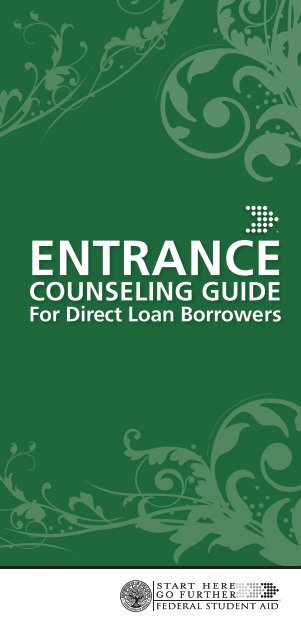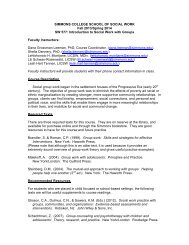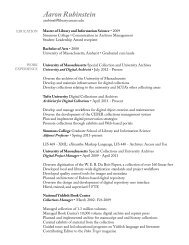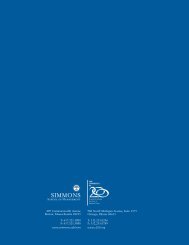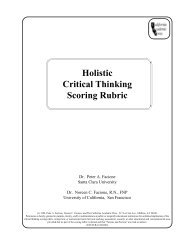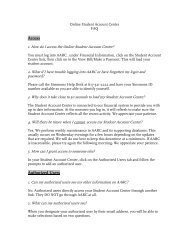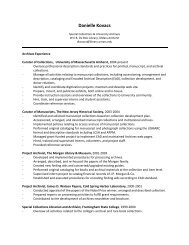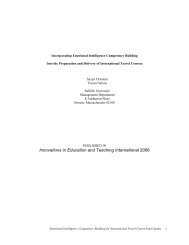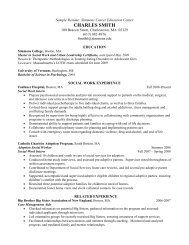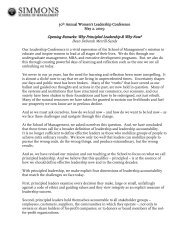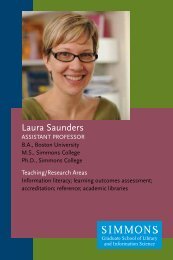Entrance Counseling Guide - Federal Direct Loans - U.S. ...
Entrance Counseling Guide - Federal Direct Loans - U.S. ...
Entrance Counseling Guide - Federal Direct Loans - U.S. ...
Create successful ePaper yourself
Turn your PDF publications into a flip-book with our unique Google optimized e-Paper software.
ENTRANCE<br />
COUNSELING GUIDE<br />
For <strong>Direct</strong> Loan Borrowers
Contents<br />
<strong>Direct</strong> Loan Types 1<br />
Borrow Wisely 2<br />
Borrow <strong>Direct</strong> Subsidized <strong>Loans</strong> and<br />
<strong>Direct</strong> Unsubsidized <strong>Loans</strong> First 2<br />
You Must Repay Your <strong>Loans</strong> 3<br />
Use of Your Loan Money 3<br />
The Master Promissory Note 4<br />
How Your <strong>Loans</strong> Will Be Disbursed (Paid Out) 4<br />
<strong>Direct</strong> Subsidized and Unsubsidized Loan Limits 5<br />
<strong>Direct</strong> PLUS Loan Limits 6<br />
<strong>Direct</strong> Subsidized Loan and <strong>Direct</strong> Unsubsidized<br />
Loan Interest Rates and Payment of Interest 7<br />
<strong>Direct</strong> PLUS Loan Interest Rate and Payment of Interest 8<br />
Loan Fees 8<br />
Half-time Enrollment 9<br />
Changes You Must Report 10<br />
Repaying <strong>Direct</strong> <strong>Loans</strong> 11<br />
Repayment Incentives 12<br />
Interest Rate Reduction for Automatic<br />
Withdrawal of Payments 15<br />
Up-front Interest Rebate 15<br />
Trouble Making Payments 15<br />
Consequences If You Default 16<br />
Consolidation 17<br />
Conditions for Canceling All or Part of Your Loan 17<br />
National Student Loan Data System (NSLDS) 18<br />
Keep Your Loan Papers 19<br />
Borrower’s Rights and Responsibilities 19<br />
<strong>Direct</strong> <strong>Loans</strong> on the Web: www.direct.ed.gov<br />
i
U.S. Department of Education<br />
<strong>Federal</strong> Student Aid<br />
Business Operations<br />
Operations Services<br />
Program Communications Division<br />
Publications<br />
Online Access<br />
This publication is also available at<br />
www.direct.ed.gov.<br />
Contact Information<br />
Comments and inquiries about the design and<br />
content of this publication may be sent to:<br />
FSAschoolspubs@ed.gov<br />
December 2010<br />
ii <strong>Entrance</strong> <strong>Counseling</strong> <strong>Guide</strong>
<strong>Direct</strong> Loan Types<br />
The <strong>Direct</strong> Loan Program SM offers the following<br />
types of loans:<br />
u<br />
u<br />
u<br />
<strong>Direct</strong> Subsidized <strong>Loans</strong>:<br />
■ For students with financial need.<br />
■ You must be enrolled at least half-time.<br />
■ No interest is charged while you are in school at least halftime,<br />
during your grace period, and during deferment periods.<br />
■ You do not have to make payments while you are attending<br />
school at least half-time and during your grace period.<br />
■ You will receive a six-month grace period after you drop<br />
below half-time.<br />
<strong>Direct</strong> Unsubsidized <strong>Loans</strong>:<br />
■ Not based on financial need.<br />
■ You must be enrolled at least half-time.<br />
■ Interest is charged during all periods.<br />
■ You do not have to make payments while you are attending<br />
school at least half-time and during your grace period, but<br />
interest will continue to be charged.<br />
■ You will receive a six month grace period after you drop<br />
below half-time.<br />
<strong>Direct</strong> PLUS <strong>Loans</strong>:<br />
■ Unsubsidized loans for graduate or professional students<br />
(and for parents of dependent undergraduate students).<br />
■ You must be enrolled at least half-time.<br />
■ You can borrow up to the school’s cost of attendance, less<br />
all other financial assistance you receive.<br />
■ Interest is charged during all periods.<br />
■ <strong>Direct</strong> PLUS <strong>Loans</strong> do not have a grace period. The<br />
repayment begins as soon as the loan is fully disbursed,<br />
but you may defer repayment while you are enrolled at least<br />
half-time and for an additional six months after you drop<br />
below half-time.<br />
■ To qualify for a <strong>Direct</strong> PLUS Loan, you must not have an<br />
adverse credit history. A credit check will be conducted.<br />
■ If you have an adverse credit history, you may still qualify for a<br />
<strong>Direct</strong> PLUS Loan if you obtain an endorser who does not have<br />
an adverse credit history, or if you document to our satisfaction<br />
that there are extenuating circumstances related to your adverse<br />
credit history. (An endorser is someone who agrees to repay a<br />
<strong>Direct</strong> PLUS Loan if you do not repay the loan.)<br />
<strong>Direct</strong> <strong>Loans</strong> on the Web: www.direct.ed.gov 1
u<br />
<strong>Direct</strong> Consolidation <strong>Loans</strong>:<br />
■ Eligible federal student loans can be combined into one<br />
<strong>Direct</strong> Consolidation Loan.<br />
Borrow Wisely<br />
u Your school will award you the maximum amount of loan<br />
money for which you are eligible, unless you request less.<br />
You may decline any portion or all of a loan you do not need.<br />
u Borrow conservatively. Never borrow more than you can<br />
afford to repay, even if you are eligible to borrow more.<br />
u Calculate your expenses and your resources. Use these figures<br />
to help you determine how much you really need to pay for<br />
your education. To get an idea of your college expenses, use<br />
our online budget calculator (http://direct.ed.gov).<br />
u Identify nonloan sources of financial assistance. Accepting<br />
a loan may affect your eligibility for other forms of financial<br />
aid, so you should check with your school’s financial aid office<br />
about your eligibility for private and federal nonloan aid before<br />
accepting a loan.<br />
u Look for ways to increase your income, decrease your<br />
expenses, or both.<br />
Borrow <strong>Direct</strong> Subsidized <strong>Loans</strong> and <strong>Direct</strong><br />
Unsubsidized <strong>Loans</strong> First<br />
[Applies only to graduate/professional students]<br />
u Because <strong>Direct</strong> Subsidized <strong>Loans</strong> and <strong>Direct</strong> Unsubsidized<br />
<strong>Loans</strong> offer certain advantages over <strong>Direct</strong> PLUS <strong>Loans</strong>, you<br />
should always borrow the maximum amount you are eligible to<br />
receive in <strong>Direct</strong> Subsidized <strong>Loans</strong> and/or <strong>Direct</strong> Unsubsidized<br />
<strong>Loans</strong> before you request a <strong>Direct</strong> PLUS Loan.<br />
■ The interest rate for <strong>Direct</strong> Subsidized <strong>Loans</strong> and <strong>Direct</strong><br />
Unsubsidized <strong>Loans</strong> is 6.8% (<strong>Direct</strong> Subsidized <strong>Loans</strong> for<br />
undergraduates have a lower rate). The interest rate for<br />
<strong>Direct</strong> PLUS <strong>Loans</strong> is 7.9%.<br />
■ For <strong>Direct</strong> Subsidized <strong>Loans</strong> and <strong>Direct</strong> Unsubsidized<br />
<strong>Loans</strong>, the loan fee for loans first disbursed between<br />
July 1, 2009, and June 30, 2010, is 1.5% (the fee will be 1%<br />
for loans first disbursed on or after July 1, 2010). For <strong>Direct</strong><br />
PLUS <strong>Loans</strong>, the loan fee is 4%.<br />
2 <strong>Entrance</strong> <strong>Counseling</strong> <strong>Guide</strong>
■ <strong>Direct</strong> Subsidized <strong>Loans</strong> and <strong>Direct</strong> Unsubsidized <strong>Loans</strong> have<br />
a six-month grace period that begins when you drop below<br />
half-time enrollment. The repayment period begins at the end<br />
of the six-month grace period. <strong>Direct</strong> PLUS <strong>Loans</strong> do not have<br />
a grace period. The repayment period begins when the loan is<br />
fully disbursed (though you may defer repayment while you are<br />
in school at least half-time).<br />
■ No interest is charged on <strong>Direct</strong> Subsidized <strong>Loans</strong> while you<br />
are in school at least half-time, during the grace period, and<br />
during deferment periods. Interest is charged on <strong>Direct</strong><br />
Unsubsidized <strong>Loans</strong> and <strong>Direct</strong> PLUS <strong>Loans</strong> during all<br />
periods, starting on the date of the first loan disbursement.<br />
You Must Repay Your <strong>Loans</strong><br />
u You must repay the full amount of your loans, even if you:<br />
■ Do not complete your program of study, or do not complete<br />
the program within the normal time for completing it;<br />
■ Cannot find employment after graduation; or<br />
■ Are not satisfied with or did not receive from your school the<br />
education or other services that you paid for with your loan.<br />
Use of Your Loan Money<br />
You may use your loan money only to pay for authorized<br />
educational expenses at the school that certified your loan eligibility.<br />
u Authorized educational expenses include:<br />
■ Tuition<br />
■ Room and board<br />
■ Institutional fees<br />
■ Books<br />
■ Supplies<br />
■ Equipment<br />
■ Dependent child care expenses<br />
■ Transportation and commuting expenses<br />
■ Rental or purchase of a personal computer<br />
■ Loan fees<br />
■ Other documented, authorized costs<br />
<strong>Direct</strong> <strong>Loans</strong> on the Web: www.direct.ed.gov 3
The Master Promissory Note<br />
u To take out a <strong>Direct</strong> Loan for the first time, you must<br />
complete a Master Promissory Note (MPN).<br />
u If your school offers the option of completing the MPN<br />
electronically, you can complete the MPN online at<br />
Student<strong>Loans</strong>.gov (https://studentloans.gov). You also<br />
have the option of completing a paper MPN.<br />
u The MPN is a legal document in which you promise to repay<br />
your loan(s) and any accrued interest and fees to the Department.<br />
It also explains the terms and conditions of your loan(s).<br />
u In most cases, once you’ve submitted an MPN and it’s been<br />
accepted, you won’t have to complete a new MPN for future<br />
<strong>Direct</strong> <strong>Loans</strong> SM you receive.<br />
u There is one MPN for <strong>Direct</strong> Subsidized <strong>Loans</strong> and <strong>Direct</strong><br />
Unsubsidized <strong>Loans</strong>, and a separate MPN for <strong>Direct</strong> PLUS <strong>Loans</strong>.<br />
u Unless your school does not allow more than one loan to be<br />
made under the same MPN, you can borrow additional <strong>Direct</strong><br />
<strong>Loans</strong> on a single MPN for up to 10 years.<br />
u Even if your school allows more than one loan to be made<br />
under the same MPN, you have the option of completing a<br />
new MPN for each <strong>Direct</strong> Loan that you receive. If you don’t<br />
want to receive more than one loan under a single MPN, you<br />
must notify your school or <strong>Direct</strong> Loan servicer in writing<br />
that you want the MPN you signed to be “closed” so that it<br />
cannot be used for additional loans.<br />
u For each loan that you receive under an MPN, you’ll receive<br />
a disclosure statement that gives you specific information<br />
about that loan, including the loan amount, loan fees, and<br />
the expected disbursement dates and amounts.<br />
u Although your signature on the MPN allows your school to make<br />
multiple loans to you under a single promissory note, your school<br />
must have a process for confirming whether or not you want<br />
these loans.<br />
u The confirmation process helps to ensure your control over how<br />
much you borrow by letting you know each time your school plans<br />
to award a new loan under an MPN. Your school will inform you<br />
of the confirmation process it uses.<br />
How Your <strong>Loans</strong> Will Be Disbursed<br />
(Paid Out)<br />
u In most cases your school will disburse your loan money<br />
by crediting it to your school account to pay tuition and<br />
fees, room and board, and other authorized charges.<br />
4 <strong>Entrance</strong> <strong>Counseling</strong> <strong>Guide</strong>
u Generally, your school will disburse your loan money in more<br />
than one installment, at times that are determined in accordance<br />
with federal regulations.<br />
u If the loan disbursement amount exceeds school charges,<br />
the remaining balance of the disbursement will be paid to<br />
you directly by check or other means.<br />
u You will be notified in writing each time your<br />
school disburses a portion of your loan.<br />
■ The notification will include:<br />
→ The date and the amount of the<br />
loan disbursement;<br />
→ Which loan funds are subsidized<br />
and which are unsubsidized;<br />
→ Information about your right to cancel<br />
all or a portion of the loan; and<br />
→ Procedures for canceling the loan.<br />
<strong>Direct</strong> Subsidized and<br />
Unsubsidized Loan Limits<br />
u For <strong>Direct</strong> Subsidized <strong>Loans</strong> and <strong>Direct</strong> Unsubsidized <strong>Loans</strong>,<br />
there are limits on the maximum amount you may borrow<br />
for an academic year (annual loan limits) and the maximum<br />
amount you may borrow in total for undergraduate and<br />
graduate study (aggregate loan limits).<br />
Annual Loan Limits for <strong>Direct</strong> Subsidized <strong>Loans</strong><br />
and <strong>Direct</strong> Unsubsidized <strong>Loans</strong><br />
1st-year<br />
undergraduate<br />
2nd-year<br />
undergraduate<br />
3rd-year<br />
and beyond<br />
undergraduate<br />
Graduate/<br />
Professional<br />
Dependent<br />
Students<br />
(except for students<br />
whose parents cannot<br />
borrow PLUS loans)<br />
$5,500<br />
(maximum $3,500 subsidized)<br />
$6,500<br />
(maximum $4,500 subsidized)<br />
$7,500<br />
(maximum $5,500 subsidized)<br />
N/A<br />
All graduate and<br />
professional students are<br />
considered independent<br />
Independent<br />
Students<br />
(and dependent students<br />
whose parents cannot<br />
borrow PLUS loans)<br />
$9,500<br />
(maximum $3,500 subsidized)<br />
$10,500<br />
(maximum $4,500 subsidized)<br />
$12,500<br />
(maximum $5,500 subsidized)<br />
$20,500<br />
(maximum $8,500 subsidized)<br />
<strong>Direct</strong> <strong>Loans</strong> on the Web: www.direct.ed.gov 5
u The actual loan amount you are eligible to receive is determined<br />
by your school, and is based on your academic level, whether<br />
you are dependent or independent, and other factors such as:<br />
■ The length of your program;<br />
■ Your cost of attendance;<br />
■ Your Expected Family Contribution (EFC);<br />
■ Other financial aid you receive; and<br />
■ Your remaining eligibility under the annual and aggregate<br />
loan limits.<br />
u The actual amount you receive for an academic year may be less<br />
than the maximum annual amounts shown in the chart above.<br />
u If you are enrolled in certain health professions programs, you<br />
may qualify for higher annual and aggregate limits on <strong>Direct</strong><br />
Unsubsidized <strong>Loans</strong>. Contact your school’s financial aid office<br />
for information.<br />
u The annual loan limits include both <strong>Direct</strong> Subsidized and <strong>Direct</strong><br />
Unsubsidized <strong>Loans</strong>, and any subsidized or unsubsidized <strong>Federal</strong><br />
Stafford <strong>Loans</strong> you received through the <strong>Federal</strong> Family Education<br />
Loan Program SM (FFEL SM ) for the same academic year period.<br />
Aggregate Loan Limits for <strong>Direct</strong> Subsidized <strong>Loans</strong><br />
and Unsubsidized <strong>Loans</strong><br />
Dependent<br />
Undergraduate<br />
(except for students whose parents<br />
cannot borrow PLUS loans)<br />
Independent<br />
Undergraduate<br />
(and dependant students whose<br />
parents cannot borrow PLUS loans)<br />
Graduate/Professional<br />
$31,000<br />
(maximum $23,000 subsidized)<br />
$57,500<br />
(maximum $23,000 subsidized)<br />
$138,500<br />
(maximum $65,000 subsidized)<br />
The aggregate limits include both <strong>Direct</strong> Subsidized and Unsubsidized <strong>Loans</strong> and any subsidized<br />
and unsubsidized <strong>Federal</strong> Stafford <strong>Loans</strong> you received through the FFEL Program.<br />
<strong>Direct</strong> PLUS Loan Limits<br />
[Only parents of dependent undergraduate students and graduate<br />
and professional students can borrow PLUS <strong>Loans</strong>.]<br />
u For <strong>Direct</strong> PLUS <strong>Loans</strong>, you may borrow an amount up<br />
to your cost of attendance, minus the amount of any other<br />
financial aid you receive (including <strong>Direct</strong> Subsidized and<br />
Unsubsidized <strong>Loans</strong>).<br />
u Your school will determine the actual <strong>Direct</strong> PLUS Loan<br />
amount that you are eligible to receive.<br />
6 <strong>Entrance</strong> <strong>Counseling</strong> <strong>Guide</strong>
<strong>Direct</strong> Subsidized Loan and<br />
<strong>Direct</strong> Unsubsidized Loan<br />
Interest Rates and Payment of Interest<br />
u All <strong>Direct</strong> Subsidized <strong>Loans</strong> and <strong>Direct</strong> Unsubsidized<br />
<strong>Loans</strong> have a fixed interest rate (this means that the interest<br />
rate will not change).<br />
u <strong>Direct</strong> Subsidized <strong>Loans</strong> made to undergraduate students<br />
have different fixed interest rates depending on the date the<br />
first loan disbursement is made, as shown in this chart.<br />
Date of First Disbursement<br />
Interest Rate<br />
July 1, 2009, through June 30, 2010 5.6%<br />
July 1, 2010, through June 30, 2011 4.5%<br />
July 1, 2011, through June 30, 2012 3.4%<br />
on or after July 1, 2012 6.8%<br />
u <strong>Direct</strong> Subsidized <strong>Loans</strong> made to graduate or professional<br />
students have a fixed interest rate of 6.8%.<br />
u <strong>Direct</strong> Unsubsidized <strong>Loans</strong> made to all students (undergraduate<br />
and graduate/professional) have a fixed interest rate of 6.8%.<br />
u For each loan you receive, we will send you a disclosure statement<br />
that shows the loan’s actual interest rate.<br />
u We do not charge interest on <strong>Direct</strong> Subsidized <strong>Loans</strong> while you<br />
are enrolled in school at least half-time, during your grace period,<br />
during deferment periods, and during certain periods of repayment<br />
under the Income-based Repayment Plan. Except for certain<br />
military borrowers during periods of active duty service (see your<br />
Master Promissory Note for more information), we charge<br />
interest on a <strong>Direct</strong> Subsidized Loan during all other periods<br />
(starting on the day after your grace period ends), including<br />
forbearance periods.<br />
u We charge interest on <strong>Direct</strong> Unsubsidized <strong>Loans</strong> during all<br />
periods (starting on the day out of the first loan disbursement)<br />
except for certain military borrowers during periods of active duty<br />
service (see your Master Promissory Note for more information).<br />
This includes periods while you are enrolled in school at least<br />
half-time, during your grace period, and during deferment and<br />
forbearance periods. Therefore, you will pay more interest on a<br />
<strong>Direct</strong> Unsubsidized Loan than on a <strong>Direct</strong> Subsidized Loan.<br />
u You will have the option of paying the interest that accrues<br />
on a <strong>Direct</strong> Unsubsidized Loan while you are in school<br />
and during other periods (for example, during periods<br />
of deferment or forbearance).<br />
<strong>Direct</strong> <strong>Loans</strong> on the Web: www.direct.ed.gov 7
u If you do not pay the interest as it is charged on either type of loan<br />
(for example, while you are in school on a <strong>Direct</strong> Unsubsidized<br />
Loan, or during a forbearance period on either a <strong>Direct</strong> Subsidized<br />
Loan or a <strong>Direct</strong> Unsubsidized Loan), we will add it to the unpaid<br />
principal amount of your loan. This is called “capitalization.”<br />
Capitalization increases the unpaid principal balance of your loan,<br />
and we will then charge interest on the increased principal amount.<br />
This can substantially increase the total amount you repay over the<br />
life of your loan.<br />
u Your <strong>Direct</strong> Loan servicer will send you statements telling<br />
you how much interest has accrued on your loans and your<br />
options for paying that interest while you are in school or<br />
during grace, deferment, and forbearance periods.<br />
<strong>Direct</strong> PLUS Loan Interest Rate<br />
and Payment of Interest<br />
u All <strong>Direct</strong> PLUS <strong>Loans</strong> (for both graduate/professional<br />
students and parents of dependent undergraduate students)<br />
have a fixed interest rate of 7.9%.<br />
u We charge interest on <strong>Direct</strong> PLUS <strong>Loans</strong> during all periods<br />
(starting on the day of the first loan disbursement), including<br />
while you are in school.<br />
u You will have the option of paying the interest that accrues on a<br />
<strong>Direct</strong> PLUS Loan while you are in school and during other periods<br />
(for example, during periods of deferment or forbearance).<br />
u If you do not pay the interest as it is charged on a <strong>Direct</strong> PLUS<br />
Loan while you are in school or during other periods, we<br />
will add it to the unpaid principal amount of your loan. This<br />
is called “capitalization.” Capitalization increases the unpaid<br />
principal balance of your loan, and we will then charge interest<br />
on the increased principal amount. This can substantially<br />
increase the total amount you repay over the life of your loan.<br />
u Your <strong>Direct</strong> Loan servicer will send you statements telling you<br />
how much interest has accrued on your loans and your options<br />
for paying that interest while you are in school or during<br />
deferment and forbearance periods.<br />
Loan Fees<br />
u We charge a loan fee (also called an origination fee) on <strong>Direct</strong><br />
Subsidized <strong>Loans</strong>, <strong>Direct</strong> Unsubsidized <strong>Loans</strong>, and <strong>Direct</strong> PLUS<br />
<strong>Loans</strong>. The loan fee is an expense of assuming a <strong>Direct</strong> Loan.<br />
u The loan fee is a percentage of the amount of each loan you receive,<br />
and is subtracted proportionately from each loan disbursement.<br />
u For <strong>Direct</strong> Subsidized <strong>Loans</strong> and <strong>Direct</strong> Unsubsidized <strong>Loans</strong>,<br />
the loan fee varies depending on the first disbursement<br />
date of the loan. <strong>Loans</strong> with a first disbursement date<br />
8 <strong>Entrance</strong> <strong>Counseling</strong> <strong>Guide</strong>
etween July 1, 2009, and June 30, 2010, have a loan fee<br />
of 1.5%. <strong>Loans</strong> with a first disbursement date on or after<br />
July 1, 2010, will have a loan fee of 1%.<br />
u The loan fee for all <strong>Direct</strong> PLUS <strong>Loans</strong> is 4%.<br />
u The specific loan fee that you are charged will be included<br />
in a disclosure statement you will receive after the first<br />
disbursement of your loan.<br />
Half-time Enrollment<br />
You must be enrolled at least half-time to receive a <strong>Direct</strong> Loan.<br />
For undergraduate students, federal regulations set the following<br />
minimum standards for half-time enrollment:<br />
u At schools that measure academic progress in credit hours and<br />
use semesters, trimesters, or quarters, half-time is at least six<br />
semester hours or quarter hours per term.<br />
u At schools that measure academic progress in credit hours<br />
but do not use terms, half-time is at least 12 semester hours<br />
or 18 quarter hours per academic year.<br />
u At schools that measure academic progress in clock hours,<br />
half-time is at least 12 clock hours per week.<br />
u At schools that measure academic progress in credit hours and use<br />
terms other than semesters, trimesters, or quarters, the minimum<br />
number of credit hours for half-time enrollment is determined<br />
based on the number of weeks of instructional time in the term,<br />
the number of weeks of instructional time in the program of<br />
study’s academic year, and the number of credit hours in the<br />
program’s academic year.<br />
These are the minimum requirements for half-time enrollment.<br />
Schools may choose to define half-time enrollment based on<br />
a higher number of credit or clock hours than the minimum<br />
standards shown above, and a school’s half-time enrollment<br />
standard may be different for summer school. Your school can<br />
tell you if its definition of half-time enrollment is different<br />
from these minimum standards.<br />
These minimum standards apply only to undergraduate students.<br />
If you are a graduate or professional student, the definition of halftime<br />
enrollment is determined by your school.<br />
If you drop below half-time enrollment—<br />
u The six-month grace period will begin on a <strong>Direct</strong> Subsidized<br />
Loan or <strong>Direct</strong> Unsubsidized Loan. If you resume enrollment on<br />
at least a half-time basis before the end of the six-month grace<br />
period, your loan will return to “in-school” status and you<br />
will be eligible for a full six-month grace period when you leave<br />
school or drop below half-time enrollment again.<br />
<strong>Direct</strong> <strong>Loans</strong> on the Web: www.direct.ed.gov 9
u The in-school deferment on a <strong>Direct</strong> PLUS Loan first<br />
disbursed on or after July 1, 2008, will continue for an additional<br />
six months after you drop below half-time status. If you have<br />
a <strong>Direct</strong> PLUS Loan with a first disbursement date before<br />
July 1, 2008, your in-school deferment will end when you drop<br />
below half-time and you must begin making payments, unless<br />
you receive another type of deferment or a forbearance. If you<br />
resume enrollment on at least a half-time basis, you will again<br />
qualify for an in-school deferment.<br />
Changes You Must Report<br />
u It is your responsibility to contact your <strong>Direct</strong> Loan servicer<br />
and your school if you:<br />
■ Stop attending school or drop below half-time enrollment;<br />
■ Graduate;<br />
■ Fail to enroll at the school that determined you were eligible<br />
to receive your loan;<br />
■ Do not enroll at least half-time for the loan period certified<br />
by your school;<br />
■ Transfer to another school; or<br />
■ Change your name, address, or phone number.<br />
u A scheduled break in enrollment, such as the summer session<br />
at many traditional four-year schools, is not considered an<br />
interruption in your enrollment if you are planning to return to<br />
school during the next regularly scheduled enrollment period.<br />
u You must receive exit counseling before you leave school or<br />
drop below half-time enrollment.<br />
u If you are a reservist called to active duty with the U.S. Armed<br />
Forces for more than 30 days, contact your <strong>Direct</strong> Loan<br />
servicer to let them know your status.<br />
■ If you are called or ordered to active duty for more than 30<br />
days from a reserve component of the U.S. Armed Forces,<br />
the period of your active duty service and the time necessary<br />
for you to reenroll in school after your active duty ends are not<br />
counted as part of your grace period.<br />
■ However, the total period that is excluded from your grace<br />
period may not exceed three years.<br />
■ If the call or order to active duty occurs while you are in school<br />
and requires you to drop below half-time enrollment, the start<br />
of your grace period will be delayed until after the end of the<br />
excluded period.<br />
■ If the call or order to active duty occurs during your grace<br />
period, you will receive a full six-month grace period at the<br />
end of the excluded period.<br />
10 <strong>Entrance</strong> <strong>Counseling</strong> <strong>Guide</strong>
Repaying <strong>Direct</strong> <strong>Loans</strong><br />
u You must repay the full amount of each <strong>Direct</strong> Loan you<br />
receive, plus interest.<br />
u The repayment period for each <strong>Direct</strong> Subsidized Loan and <strong>Direct</strong><br />
Unsubsidized Loan that you receive begins on the day after your<br />
grace period ends. The <strong>Direct</strong> Loan servicer will notify you of the<br />
date your first payment is due.<br />
u The repayment period for each <strong>Direct</strong> PLUS Loan that you receive<br />
begins on the date the final loan disbursement is made. There is<br />
no grace period for <strong>Direct</strong> PLUS <strong>Loans</strong>. However, you may defer<br />
making payments while you are enrolled in school at least halftime,<br />
and (for <strong>Direct</strong> PLUS <strong>Loans</strong> with a first disbursement date<br />
on or after July 1, 2008) for an additional six months after you<br />
cease to be enrolled on at least a half-time basis.<br />
u You must make payments on your loan even if you do not<br />
receive a bill or repayment notice. Billing information is<br />
sent to you as a convenience, and you are obligated to make<br />
payments even if you do not receive a notice or bill.<br />
u There are five repayment plans with different terms that are<br />
designed to meet the financial needs of almost any borrower.<br />
If you can show that the terms of these plans are not adequate<br />
to meet your exceptional circumstances, we may provide you<br />
with an alternative repayment plan.<br />
u You can change repayment plans at any time by going to your<br />
<strong>Direct</strong> Loan servicer’s website and logging in to your account.<br />
u You may prepay all or any part of the unpaid balance on your<br />
loans at any time without penalty.<br />
u You may choose one of the following repayment plans<br />
to repay your loans:<br />
■ Standard Repayment Plan—You will make fixed monthly<br />
payments and repay your loans in full within 10 years (not<br />
including periods of deferment or forbearance) from the date<br />
the loans entered repayment. Your payments must be at least<br />
$50 a month and will be more, if necessary, to repay the loans<br />
within the required time period.<br />
■ Graduated Repayment Plan—You will make lower payments at<br />
first, and your payments will gradually increase over time,<br />
generally every two years. You will repay your loans in full within<br />
10 years (not including periods of deferment or forbearance)<br />
from the date the loans entered repayment. No single payment<br />
will be more than three times greater than any other payment.<br />
■ Extended Repayment Plan—To be eligible for this plan, your<br />
<strong>Direct</strong> Loan balance must be greater than $30,000. You have<br />
the option of making a fixed monthly payment amount, or a<br />
graduated payment amount that starts out lower and increases<br />
over time. Your monthly payments will be at least $50, and<br />
<strong>Direct</strong> <strong>Loans</strong> on the Web: www.direct.ed.gov 11
you will have up to 25 years to repay your loans (not including<br />
periods of deferment or forbearance).<br />
■ Income Contingent Repayment Plan—Your monthly payment<br />
amount will be based on your annual income (and that of your<br />
spouse if you are married), your family size, and the total amount<br />
of your <strong>Direct</strong> <strong>Loans</strong>. Until we obtain the information needed<br />
to calculate your monthly payment amount, your payment will<br />
equal the amount of interest that has accrued on your loans<br />
unless you request forbearance. As your income changes, your<br />
payments may change. If you do not repay your loans after<br />
25 years under this plan, the unpaid portion will be forgiven.<br />
You may have to pay income tax on any amount forgiven.<br />
■ Income-based Repayment Plan—To qualify for this plan, you<br />
must have a partial financial hardship. This means that your<br />
federal student loan debt must be high relative to your income<br />
and family size, as determined under federal regulations.<br />
Under this plan, during any period when you have a partial<br />
financial hardship your required monthly payment is capped<br />
at an amount that is intended to be affordable based on your<br />
income and family size. Your monthly payment amount may<br />
be adjusted annually. If you repay under this plan and meet<br />
certain requirements over a 25-year period, any outstanding<br />
balance on your loans will be forgiven. You can obtain more<br />
information about the Income-based Repayment Plan in the<br />
“Repaying Your <strong>Loans</strong>” section of Student Aid on the Web<br />
(http://studentaid.ed.gov).<br />
Repayment Incentives<br />
u A repayment incentive is a benefit (such as a reduced interest rate)<br />
that is offered to encourage you to repay your loans on time. You<br />
may be required to make a certain number of payments on time<br />
to keep the benefits of the repayment incentive.<br />
u The two repayment incentive programs described on page 15<br />
may be available to you. Your <strong>Direct</strong> Loan servicer can tell you if<br />
any other repayment incentive programs are available.<br />
12 <strong>Entrance</strong> <strong>Counseling</strong> <strong>Guide</strong>
Sample Monthly Payments for <strong>Direct</strong> Subsidized and Unsubsidized <strong>Loans</strong><br />
<strong>Direct</strong> Subsidized and Unsubsidized Borrowers 1<br />
Initial Debt<br />
When You<br />
Enter<br />
Repayment<br />
Per<br />
Month<br />
Standard<br />
Total<br />
Per<br />
Month<br />
Extended<br />
Fixed<br />
Total<br />
Per<br />
Month<br />
Extended<br />
Graduated<br />
Total<br />
Per<br />
Month<br />
Graduated<br />
Total<br />
Income Contingent 2<br />
Income = $25,000<br />
Income-Based 2<br />
Income = $25,000<br />
Single Married/HOH 3 Single Married/HOH 3<br />
$5,000 $58 $6,904 Not Available Not Available $40 $7,275 $37 $8,347 $36 $11,088 Not Available $39 $8,005<br />
10,000 115 13,809 Not Available Not Available 79 14,550 75 16,699 71 22,158 110 13,672 39 16,081<br />
25,000 288 34,524 Not Available Not Available 198 36,375 186 41,748 178 55,440 110 45,014 39 60,754<br />
50,000 575 69,048 347 104,109 284 112,678 396 72,749 247 93,322 189 122,083 110 109,623 39 92,704<br />
100,000 1,151 138,096 694 208,217 568 225,344 792 145,498 247 187,553 189 170,153 110 118,058 39 97,020<br />
Per<br />
Month<br />
Total<br />
Per<br />
Month<br />
Total<br />
Per<br />
Month<br />
Total<br />
Per<br />
Month<br />
Total<br />
1 Payments were calculated using a fixed interest rate of 6.8% for <strong>Direct</strong> Subsidized and Unsubsidized <strong>Loans</strong> disbursed on or after July 1, 2006.<br />
2 Assumes a 5% annual income growth (Census Bureau).<br />
3 HOH is Head of Household. Assumes a family size of two.<br />
<strong>Direct</strong> <strong>Loans</strong> on the Web: www.direct.ed.gov 13
Sample Monthly Payments for <strong>Direct</strong> PLUS <strong>Loans</strong> 1<br />
Initial Debt<br />
When You<br />
Enter<br />
Repayment<br />
Per<br />
Month<br />
Standard Graduated Extended 3<br />
Total<br />
Per<br />
Month 2<br />
Total<br />
Per<br />
Month<br />
Total<br />
$2,500 50 3,042 25 3,746 Not Available<br />
$5,000 60 7,248 42 7,694 Not Available<br />
$7,500 91 10,872 63 11,543 Not Available<br />
$10,000 121 14,496 84 15,388 Not Available<br />
$15,000 181 21,744 127 23,083 Not Available<br />
$20,000 242 28,992 169 30,778 Not Available<br />
$25,000 302 36,240 211 38,472 Not Available<br />
$30,000 362 43,488 253 46,166 Not Available<br />
$35,000 423 50,736 295 53,859 268 80,346<br />
$40,000 483 57,984 338 61,554 306 91,824<br />
$45,000 544 65,232 380 69,248 344 103,302<br />
$50,000 604 72,480 422 76,942 383 114,781<br />
$55,000 664 79,708 464 84,636 421 126,259<br />
$60,000 725 86,976 507 92,330 459 137,737<br />
$65,000 785 94,224 549 100,023 497 149,215<br />
$70,000 846 101,472 591 107,718 536 160,693<br />
$75,000 906 108,720 633 115,413 574 172,171<br />
$80,000 966 115,968 675 123,107 612 183,649<br />
$90,000 1,087 130,464 760 138,496 689 206,605<br />
$100,000 1,208 144,960 844 153,882 765 229,561<br />
$110,000 1,329 159,456 929 169,270 842 252,517<br />
$120,000 1,450 173,952 1,013 184,661 918 275,473<br />
$130,000 1,570 188,448 1,097 200,047 995 298,429<br />
$140,000 1,691 202,944 1,182 215,435 1,071 321,385<br />
$150,000 1,812 217,440 1,266 230,824 1,148 344,342<br />
1 The estimated payments were calculated using the maximum interest rate for<br />
<strong>Direct</strong> PLUS Loan borrowers, 7.9%.<br />
2 This is your beginning payment, which may increase.<br />
3 You may choose the Extended Repayment Plan only if (1) you had no outstanding balance on a<br />
<strong>Direct</strong> Loan Program loan as of Oct. 7, 1998, or on the date you obtained a <strong>Direct</strong> Loan Program<br />
loan after Oct. 7, 1998, and (2) you have an outstanding balance on <strong>Direct</strong> Loan Program loans<br />
that exceeds $30,000. Under the Extended Repayment Plan, you may choose to make fixed or<br />
graduated monthly payments. This example shows fixed monthly payments.<br />
You can also estimate what your monthly loan<br />
payments will be after you graduate by using our<br />
online repayment calculator (http://direct.ed.gov).<br />
14 <strong>Entrance</strong> <strong>Counseling</strong> <strong>Guide</strong>
Interest Rate Reduction for Automatic<br />
Withdrawal of Payments<br />
u Under the Automatic Withdrawal payment option, your<br />
bank automatically deducts your monthly loan payment<br />
from your checking or savings account and sends the<br />
payment to the <strong>Direct</strong> Loan servicer.<br />
u In addition to helping to ensure that your payments are made<br />
on time, you receive an interest rate reduction of 0.25% while<br />
you repay under the Automatic Withdrawal option.<br />
u Your <strong>Direct</strong> Loan servicer will include information about<br />
the Automatic Withdrawal option in your first bill.<br />
Up-front Interest Rebate<br />
u You may receive an up-front interest rebate on your loan.<br />
■ The rebate is equal to a percentage of the loan amount<br />
that you borrow.<br />
■ This is the same amount that would result if the interest<br />
rate on your loan were lowered by a specific percentage, but<br />
you receive the rebate up front.<br />
■ The correspondence that you receive about your loan<br />
will indicate if you received an up-front interest rebate.<br />
u To keep an up-front interest rebate that you receive on your<br />
loan, you must make all of your first 12 required monthly<br />
payments on time when your loan enters repayment.<br />
■ “On time” means that we must receive each payment no<br />
later than six days after the due date.<br />
■ You will lose the rebate if you do not make all of your first<br />
12 required monthly payments on time.<br />
■ If you lose the rebate, your <strong>Direct</strong> Loan servicer will add the<br />
rebate amount back to the principal balance on your loan<br />
account. This will increase the amount that you must repay.<br />
Trouble Making Payments<br />
u If you’re having trouble making payments on your loans,<br />
contact your <strong>Direct</strong> Loan servicer as soon as possible to discuss<br />
options that may help you.<br />
u Options include:<br />
■ Changing repayment plans.<br />
■ Deferment, if you meet certain requirements (for example,<br />
if you are unable to find full-time employment, or are<br />
experiencing an economic hardship). A deferment allows<br />
you to temporarily stop making payments on your loan.<br />
<strong>Direct</strong> <strong>Loans</strong> on the Web: www.direct.ed.gov 15
■ Forbearance, if you don’t meet the eligibility requirements for<br />
a deferment but are temporarily unable to make your loan<br />
payments. Forbearance allows you to temporarily stop making<br />
payments on your loan, temporarily make smaller payments,<br />
or extend the time for making payments.<br />
u If you stop making payments and don’t get a deferment or<br />
forbearance, your loan could go into default, which has<br />
serious consequences.<br />
u Your loan first becomes “delinquent” if your monthly payment<br />
is not received by the due date.<br />
u If you fail to make a payment, your <strong>Direct</strong> Loan servicer<br />
will send you a reminder that your payment is late.<br />
u If your account remains delinquent, your <strong>Direct</strong> Loan<br />
servicer will send you warning notices reminding you of<br />
your obligation to repay your loans and the consequences of<br />
default.<br />
u If you are delinquent on your loan payments, contact your<br />
<strong>Direct</strong> Loan servicer immediately to find out how to bring<br />
your account current.<br />
■ Late fees may be added, and your delinquency will be reported<br />
to one or more national consumer reporting agencies (credit<br />
bureaus), but this is much better than remaining delinquent on<br />
your payments and going into default.<br />
Consequences If You Default<br />
Default occurs when you become 270 days past due (delinquent)<br />
in making a payment on your loan(s). The consequences of<br />
default can be severe.<br />
■ The entire unpaid balance of your loan and accrued interest<br />
becomes due and payable immediately.<br />
■ You lose eligibility for deferment.<br />
■ You lose eligibility for additional federal student financial aid.<br />
■ Your account is assigned to a collection agency.<br />
■ The default will be reported as delinquent to credit bureaus,<br />
damaging your credit rating.<br />
■ The federal government can take all or part of<br />
your federal tax refund.<br />
■ Late fees, additional interest, court costs, collection fees,<br />
attorney’s fees, and other costs incurred in collecting your loan<br />
will increase your loan debt.<br />
■ Your employer (at the request of the federal government) can<br />
garnish part of your wages and send them to the government.<br />
■ The federal government can take legal action against you.<br />
16 <strong>Entrance</strong> <strong>Counseling</strong> <strong>Guide</strong>
Consolidation<br />
u If you have multiple federal education loans, you can consolidate<br />
them into a single <strong>Direct</strong> Consolidation Loan.<br />
u This may simplify repayment if you are making separate loan<br />
payments to different loan holders, as you’ll only have one<br />
monthly payment to make. There may be tradeoffs, however,<br />
so you’ll want to learn about the advantages and possible<br />
disadvantages of consolidation before you consolidate.<br />
u To learn more, visit our <strong>Direct</strong> Consolidation<br />
Loan website (http://loanconsolidation.ed.gov).<br />
Conditions for Canceling All<br />
or Part of Your Loan<br />
u<br />
Teacher Loan Forgiveness<br />
■ If you are a new borrower* and teach full-time in a lowincome<br />
elementary or secondary school, or in a lowincome<br />
educational service agency, for five consecutive<br />
years and meet certain other requirements, you may be<br />
able to have as much as $17,500 of your <strong>Direct</strong> Subsidized<br />
<strong>Loans</strong> and <strong>Direct</strong> Unsubsidized <strong>Loans</strong> forgiven.<br />
■ This loan forgiveness benefit is not available for<br />
<strong>Direct</strong> PLUS <strong>Loans</strong>.<br />
■ For more information, see Student Aid on the Web<br />
(http://studentaid.ed.gov).<br />
You are considered a new borrower if you did not have<br />
an outstanding balance on an FFEL or <strong>Direct</strong> Loan on<br />
Oct. 1, 1998, or on the date you obtained a <strong>Direct</strong> Loan<br />
after Oct. 1, 1998.<br />
u<br />
Public Service Loan Forgiveness<br />
■ If you are employed in certain public service jobs and have<br />
made 120 payments on your <strong>Direct</strong> <strong>Loans</strong> (after Oct. 1, 2007),<br />
the remaining balance that you owe may be forgiven.<br />
■ Only payments made under certain repayment plans may<br />
be counted toward the required 120 payments.<br />
■ You must not be in default on the loans that are forgiven.<br />
For more information on Public Service Loan Forgiveness,<br />
see our online guide in the “Repaying Your <strong>Loans</strong>” section<br />
of Student Aid on the Web (http://studentaid.ed.gov).<br />
<strong>Direct</strong> <strong>Loans</strong> on the Web: www.direct.ed.gov 17
u<br />
u<br />
School-related discharges<br />
In certain cases, you may be able to have all or a part<br />
of your loan canceled because:<br />
■ Your school closed before you completed your program.<br />
■ Your school forged your signature on your promissory note<br />
or falsely certified that you were eligible to get the loan.<br />
■ Your loan was falsely certified as a result of the crime of identity<br />
theft (additional requirements apply).<br />
■ You withdrew from school but the school didn’t pay a refund<br />
that it owed under our regulations.<br />
Disability, bankruptcy, or death<br />
■ Your loan may be discharged if you are determined to<br />
be totally and permanently disabled and you meet certain<br />
other requirements.<br />
■ Your loan may be canceled if it is discharged in bankruptcy.<br />
This is not an automatic process—you must prove to the<br />
bankruptcy court that repaying the loan<br />
would cause undue hardship.<br />
■ Your loan will be canceled if a family member or other<br />
representative provides acceptable documentation of<br />
your death.<br />
Contact your <strong>Direct</strong> Loan servicer for more information<br />
about loan cancellation benefits.<br />
National Student Loan<br />
Data System SM (NSLDS SM )<br />
u You can find information about all of your <strong>Direct</strong> <strong>Loans</strong>, FFEL<br />
Program <strong>Loans</strong>, and <strong>Federal</strong> Perkins <strong>Loans</strong> by accessing the<br />
Department’s National Student Loan Data System SM (NSLDS SM )<br />
at www.nslds.ed.gov or by calling toll free 1-800-999-8219.<br />
■ You will need your federal student aid PIN to access NSLDS.<br />
■ NSLDS does not include information about any private loans<br />
you may have received.<br />
18 <strong>Entrance</strong> <strong>Counseling</strong> <strong>Guide</strong>
Keep Your Loan Papers<br />
u Remember to keep copies of all of your loan papers in one place.<br />
■ These provide you with a record of the terms of your loan(s)<br />
and how much you have borrowed.<br />
■ Copies of your MPN are available at Student<strong>Loans</strong>.gov<br />
(https://studentloans.gov) if you complete your<br />
MPN electronically.<br />
■ If you choose to receive electronic correspondence<br />
from the Department, copies of that correspondence,<br />
including loan disclosure statements will also be available<br />
from Student<strong>Loans</strong>.gov.<br />
Borrower’s Rights and Responsibilities<br />
If you have questions about the borrower’s rights and responsibilities<br />
or the terms and conditions of your loan(s), you may contact<br />
Applicant Services.<br />
U.S. Department of Education<br />
Attn: COD Applicant Services<br />
P.O. Box 9002<br />
Niagara Falls, NY 14302<br />
Phone: 1-800-557-7394<br />
email: codsupport@acs-inc.com<br />
Your school’s financial aid office can also assist you if you have<br />
questions about the borrower’s rights and responsibilities or<br />
the terms and conditions of your loan(s).<br />
<strong>Direct</strong> <strong>Loans</strong> on the Web: www.direct.ed.gov 19
20 <strong>Entrance</strong> <strong>Counseling</strong> <strong>Guide</strong>
Borrower’s Rights and<br />
Responsibilities<br />
Your school may ask you to sign this checklist to document that you<br />
completed entrance counseling.<br />
I understand I have the right to:<br />
u Written information on my loan obligations and information<br />
on my rights and responsibilities as a borrower<br />
u A copy of my MPN either before or at the time my loan is disbursed<br />
u A grace period and an explanation of what this means<br />
u Notification, if I am in my grace period or repayment, no later than 45<br />
days after a lender assigns, sells or transfers my loan to another lender<br />
u A disclosure statement, received before I begin to repay my loan, that<br />
includes information about interest rates, fees, the balance I owe, and a<br />
loan repayment schedule<br />
u Deferment or forbearance of repayment for certain defined periods, if<br />
I qualify and if I request it<br />
u Prepayment of my loan in whole or in part anytime without an earlyrepayment<br />
penalty<br />
u Documentation that my loan is paid in full<br />
I understand I am responsible for:<br />
u Completing exit counseling before I leave school or drop below halftime<br />
enrollment<br />
u Repaying my loan according to my repayment schedule even if I do not<br />
complete my academic program, I am dissatisfied with the education I<br />
received, or I am unable to find employment after I graduate<br />
u Notifying my lender or loan servicer if I:<br />
■ Move or change my address<br />
■ Change my telephone number<br />
■ Change my name<br />
■ Change my social security number<br />
■ Change employers or my employer’s address<br />
or telephone number changes<br />
u Making monthly payments on my loan after my grace period ends,<br />
unless I have a deferment or forbearance<br />
u Notifying my lender or loan servicer of anything that might alter my<br />
eligibility for an existing deferment or forbearance<br />
I have received entrance counseling materials for <strong>Direct</strong> Loan borrowers.<br />
I have read and I understand my rights and responsibilities as a borrower.<br />
I understand that I have a loan from the federal government that must be<br />
repaid.<br />
Student’s Signature<br />
Date<br />
Student’s Name (Please Print)<br />
<strong>Direct</strong> <strong>Loans</strong> on the Web: www.direct.ed.gov 21
This page intentionally<br />
left blank<br />
22 <strong>Entrance</strong> <strong>Counseling</strong> <strong>Guide</strong>


